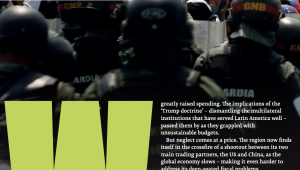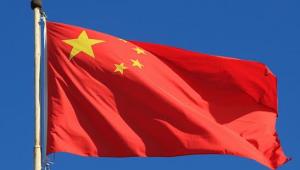When Donald Trump entered the White House, economists in Latin America were distracted.
They were busy figuring out how to tighten public finances after the commodity boom that had enabled their governments to lift millions out of poverty through greatly raised spending. The implications of the ‘Trump doctrine’ – dismantling the multilateral institutions that have served Latin America well – passed them by as they grappled with unsustainable budgets.
But neglect comes at a price. The region now finds itself in the crossfire of a shootout between its two main trading partners, the US and China, as the global economy slows – making it even harder to address its deep-seated fiscal problems.
Alejandro Izquierdo, head of the Research Department at the Inter-American Development Bank, says: “Latin America is particularly vulnerable to the types of shocks or events that are taking place.”
The problem, says Izquierdo, is that many policymakers maintained spending levels during the boom – which ended in 2014 – because they thought it would last.
“In 2007 just prior to the US financial crisis, the region was running, on average, a 1% of GDP fiscal surplus, and now we are somewhere in the neighbourhood of a 4% fiscal deficit.”
 Peter Kingstone, professor of politics and development at King’s College London, says Latin Americans now talk of the period 2000–2014 as a “golden age”, whose abrupt end may help to explain the political tensions welling up in countries like Venezuela. [Pictured right: Venezuela opposition leader Juan Guaidó gives the thumbs-up to supporters].
Peter Kingstone, professor of politics and development at King’s College London, says Latin Americans now talk of the period 2000–2014 as a “golden age”, whose abrupt end may help to explain the political tensions welling up in countries like Venezuela. [Pictured right: Venezuela opposition leader Juan Guaidó gives the thumbs-up to supporters].
“Latin America is a vulnerable region that doesn’t really have great options on the table right now,” he says.
“You can’t offer your public more in terms of social welfare and balance the books and promote economic competitiveness and economic growth all at the same time. Something has to give.”
The combination in the early 2000s of low interest rates and high commodity prices encouraged a public spending binge, with the large Latin American commodity exporters increasing expenditure, on average, from 20% to 30% of GDP.
Following the US downturn, many adopted expansionary policies that locked in spending increases through higher wages and social transfers.
Latin America’s largest economy, Brazil, exemplifies the problems this caused – its pensions deficit alone hit US$61.3bn (£48bn) in 2017.
This region now finds itself squeezed on all sides after a fragile recovery in 2018 begins to stall and external factors weigh down its prospects. Growth projections have been scaled back to between 1.8% and 2.2%.
Latin America faces two main threats. The IDB is scrutinising US monetary policy and interest rates, which can change rapidly, with a knock-on effect upon public finances.Low rates were key to unprecedented Latin American spending levels during the boom, but the Federal Reserve has been pushing up rates since 2015 and is in no mood to stop.
Mark Miller, senior research fellow at the Overseas Development Institute, said this could have a direct impact on Latin American public finances.
“There are expectations they will raise interest rates further, and one of the knock-on effects of that has been a big move out of emerging market capital markets, and so you have seen a big rise in interest rates in places like Brazil and Argentina, which is actually having a big effect on their overall fiscal space.”
The headlines, however, are focusing on Trump’s emblematic protectionism.
While his hostility to free trade with Mexico and retreat from the Trans-Pacific Partnership were expected, Latin America is more worried about his effect on China.
China’s economy has bombed, and in February Beijing reported that exports plunged by 20% year-on-year.
Latin America’s trade with China was worth US$258bn in 2017 and the region’s exports to the country are growing at double the rates of those to the US and Europe.
US-China trade tensions could weigh heavily upon countries integrated in international supply chains, such as Mexico and Brazil, further reducing their fiscal space.
The IDB is watching the US-China talks like a hawk, and believes that if there is no deal – and hence 25% US tariffs on $250bn of Chinese exports – this could shave Latin American growth by up to 0.5% of GDP, making belt-tightening crucial (see box below).
Izquierdo says: “That may not look like much, but if you consider the region is growing at 2% on average, then it is no minor impact.”
At the same time, Kingstone notes that while protectionism is new, Trump’s foreign policy stance reflects continuity with predecessors.
Headlines suggest he is taking a more muscular role in Latin America – such as his veiled threat of military action against Venezuela – yet Washington’s relations with the region continue to be characterised, above all, by disinterest.
“Clearly, his instincts are protectionist, and that can’t be good for Latin America. He has enhanced the normal neglect of the region that you can expect from US administrations. So you have neglect, coupled with trade tensions.”
Given Trump’s protectionist reflex, some analysts have wondered whether Latin America could follow suit – evoking memories of an historic era of tariff barriers between the 1950s and 1970s.
Kingstone is sceptical, but notes that countries in the region have singularly failed to improve their competitiveness – increasing the temptation to protect domestic sectors.
Many of us have actually thought that some level of protection of the manufacturing sector is important – but, of course, a disorganised policy like Trump’s would be a disaster
- Diego Sánchez-Ancochea, Latin American Centre, Oxford University
“One of the complaints about the period of the 2000s is that, with very few exceptions, none of these Latin American governments said ‘Know what? It’s a commodity boom, it’s going to end, what do we do to address competitiveness problems in our industries and economies?’
“Very few of them made real advances in solving all sorts of obstacles to competitiveness,” he adds.
Diego Sánchez-Ancochea, professor of the political economy of development at Oxford University’s Latin American Centre, suspects Trump could invoke a “copycat element”, although it is hard to predict where. “The question is: will this be good or bad for the region? And that is unclear, because many of us have actually thought that some level of protection of the manufacturing sector is important – but, of course, a disorganised policy like Trump’s would be a disaster.”
Brazil’s new populist president Jair Bolsonaro, in particular, styles himself on the US leader. However, Sánchez-Ancochea points out that a struggle is under way in Brazil’s new conservative administration between advocates of neoliberalism and more traditional statists. “Bolsonaro is a statist by nature – at the end of the day, military men in general are about strengthening the state – and so in quite a few areas conflicts will exist. It is an administration that will be in continuous paradoxes.”
Longstanding trade tensions between Brazil and the US will also limit potential solidarity among the hemisphere’s new conservatives. However, Trump’s protectionism could bolster the Brazilian leader’s fiscal crusade.
Miller says: “In some terms, it gives Bolsonaro greater authority to act, because there is just less money around and it potentially makes it easier for him to get consensus behind reform.”
Yet despite the temptations of tariffs, perhaps the greatest irony of US protectionism is that it could transform Latin America into an unlikely champion of free trade.
There are already hints that Trump’s trade agenda is invigorating the sluggish convergence under way between the region’s two main trade blocs, Mercosur and the Pacific Alliance.
Izquierdo says: “Both in Brazil and Argentina, you have governments that are much more keen on engaging in trade, and since [they] are the biggest members of Mercosur, that could be quite beneficial for the region. Paradoxically, there is an opportunity to integrate more within the region.”
Spend smarter, urges IDB
Latin American governments could save up to 4.5% of GDP by spending better – helping them solve a puzzle facing middle-income countries: how to meet rising fiscal demands while tightening public finances.
The Inter-American Development Bank believes the region has reached a “crucial juncture” following the public finance bonanza of the commodity boom in the new context of higher world interest rates, lower commodity prices and lower global growth.
Alejandro Izquierdo is the lead author of an IDB report encouraging governments to “do more with less” through “smart spending” rather than the standard fare of across-the-board cuts.
“We looked into the components of public expenditure to see what room for smart adjustment there was, and found three particular areas where there is a lot of fat you can cut.”
Social transfers tailored to the poor that have proven transformative in Latin America are also reaching middle-income groups, and better targeting could save governments 1.5% of GDP, he says.
Reducing wage differentials benefiting low-skilled public sector workers – who earn about 25% more than their private sector peers – could save another 1.5%, as could more efficient government procurement
Izquierdo notes that a fourth bloated area is pension spending – an issue that Brazil is now grappling with.
“When you look at the ratios of how much countries spend between the old and the young, they are startling: on average, we spend four times more on the old than we do on young children, and in cases like Brazil it goes all the way up to six.”















